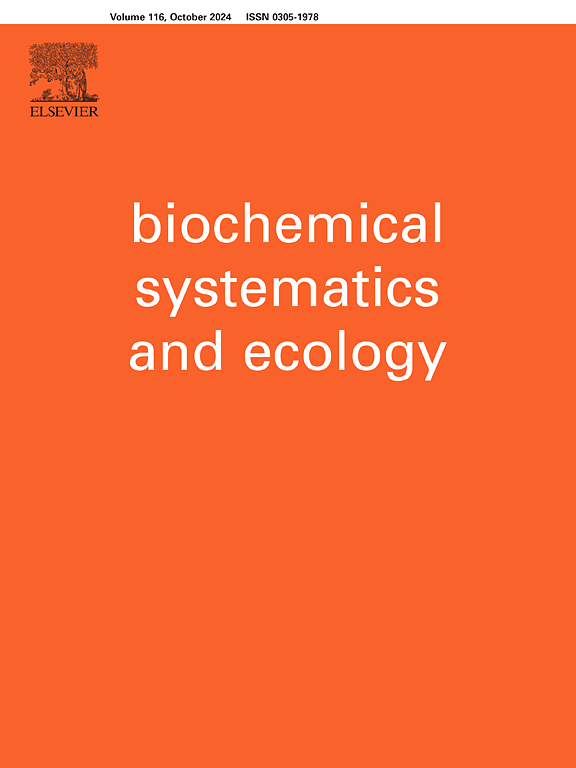Calophyllum brasiliense Cambess形态型的植物化学和化学计量学研究。(Calophyllaceae)生长在巴西圣Espírito山区
IF 1.4
4区 生物学
Q4 BIOCHEMISTRY & MOLECULAR BIOLOGY
引用次数: 0
摘要
Calophyllum brasiliense。是美洲大陆热带森林中高度多样化的物种,因其具有植物治疗潜力而被传统社区所认可。这种多样性与其高度的生态可塑性有关,使其能够合成各种次生代谢物,如酚类化合物、香豆素、色素、山酮、萜烯和类黄酮,这些都具有多种生物学特性。基于形态、遗传和化学证据,利用化学计量学和光谱技术,对巴西桑托州Espírito山区巴西棘猴(C. brasiliense)种群中不同形态型的相似性和差异性进行了研究。采用醋酸乙酯:二氯甲烷溶液(1:1,v/v)萃取c。巴西螺叶被证明可以有效地提取富含多酚的提取物。多变量分析和红外光谱分析结果表明,不同形态型的代谢谱相似,突出了多酚类化合物的存在,重点是Jacareuba和Diamond形态型。电喷雾电离ESI(−/+)FT-ICR分析鉴定出20种化学物质,其中有12-乙酰基没食子酸、乳型香豆素(B/BB和A/BB)和吡喃香豆素(pyranocoumarin inophyllum c)。基于这些结果,我们提出了种群中存在不同化学型的可能性,强调需要进一步的化学计量学分析、分子研究和生物活性评估来更准确地了解。本文章由计算机程序翻译,如有差异,请以英文原文为准。
Phytochemical and chemometric investigation of morphotypes of Calophyllum brasiliense Cambess. (Calophyllaceae) in the mountainous region of Espírito Santo, Brazil
Calophyllum brasiliense Cambess. is a highly diverse species in the tropical forests of the American continent, recognized by the traditional community for its phytotherapeutic potential. This diversification is associated with its high ecological plasticity, giving it the ability to synthesize various secondary metabolites such as phenolic compounds, coumarins, chromones, xanthones, terpenes, and flavonoids, all with multiple biological properties. Based on morphological, genetic, and chemical evidences indicating the existence of chemotypes within the species, chemometric and spectroscopic techniques were employed to investigate the similarity or dissimilarity of different morphotypes in a population of C. brasiliense located in the mountainous region of the state of Espírito Santo, Brazil. The ethyl acetate: dichloromethane solution (1:1, v/v) used for secondaries metabolites extraction from.
C. brasiliense leaves proved effective in obtaining extracts rich in polyphenols. The results of multivariate analyses and infrared spectroscopy indicated similar metabolic profiles among morphotypes, highlighting the presence of polyphenolic compounds, with emphasis on the Jacareuba and Diamond morphotypes. Electrospray ionization ESI (−/+) FT-ICR analysis enabled the identification of 20 chemical substances, with notable mention of the chromone 12-acetyl apetalic acid, mammea-type coumarins (B/BB and A/BB), and the pyranocoumarin inophyllum C. Regarding the quantification of gallic acid, both morphotypes showed low levels. Based on the results, we suggest the possibility of different chemotypes within the population, emphasizing the need for further chemometric analyses, molecular studies, and biological activity assessments for a more accurate understanding.
求助全文
通过发布文献求助,成功后即可免费获取论文全文。
去求助
来源期刊

Biochemical Systematics and Ecology
生物-进化生物学
CiteScore
3.00
自引率
12.50%
发文量
147
审稿时长
43 days
期刊介绍:
Biochemical Systematics and Ecology is devoted to the publication of original papers and reviews, both submitted and invited, in two subject areas: I) the application of biochemistry to problems relating to systematic biology of organisms (biochemical systematics); II) the role of biochemistry in interactions between organisms or between an organism and its environment (biochemical ecology).
In the Biochemical Systematics subject area, comparative studies of the distribution of (secondary) metabolites within a wider taxon (e.g. genus or family) are welcome. Comparative studies, encompassing multiple accessions of each of the taxa within their distribution are particularly encouraged. Welcome are also studies combining classical chemosystematic studies (such as comparative HPLC-MS or GC-MS investigations) with (macro-) molecular phylogenetic studies. Studies that involve the comparative use of compounds to help differentiate among species such as adulterants or substitutes that illustrate the applied use of chemosystematics are welcome. In contrast, studies solely employing macromolecular phylogenetic techniques (gene sequences, RAPD studies etc.) will be considered out of scope. Discouraged are manuscripts that report known or new compounds from a single source taxon without addressing a systematic hypothesis. Also considered out of scope are studies using outdated and hard to reproduce macromolecular techniques such as RAPDs in combination with standard chemosystematic techniques such as GC-FID and GC-MS.
 求助内容:
求助内容: 应助结果提醒方式:
应助结果提醒方式:


